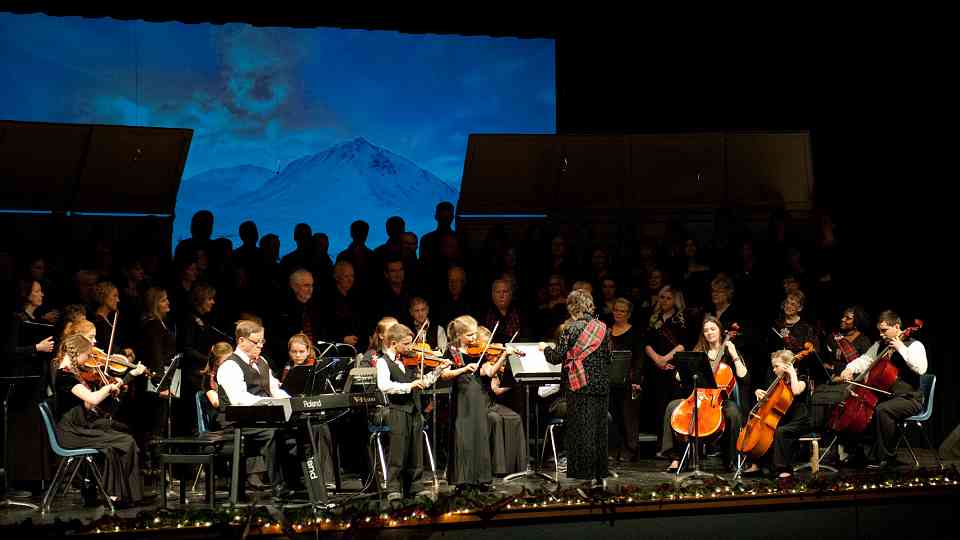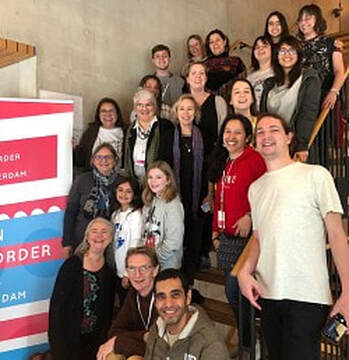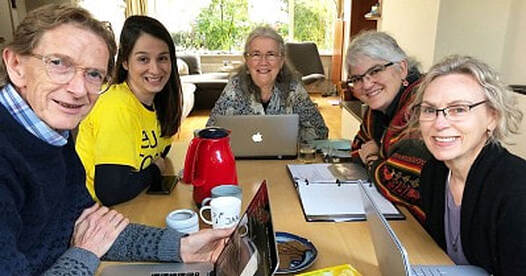|
By Margot Jewell - Toronto, Ontario
Lance Stoney is the only Suzuki trained violin teacher in Fort St. John, a BC town of 20,000 on the Alaska Highway, a 14-hour drive from Vancouver. He has one Suzuki colleague in town, a pianist. The nearest Suzuki violin teachers are in Prince George (4 1/2 hours) and Edmonton (7 hours away). These distances make it difficult to collaborate with musicians outside of Fort St. John, although Lance and some of his senior students participate in a summer orchestra program in Smithers, BC (9 1/2 hours away). At age 3, Lance started studying violin at a Suzuki program in southern BC. He kept playing through high school, and took some RCM practical and theory exams. Then when he started working at other jobs, music went on the back burner. Thirteen years ago Lance moved to Fort St. John for work. People in the community learned he played the violin and a child wanted to start studying with Lance. By 2018, his studio had grown to 60 students so he was able to give up his job in the oil patch. In a phone conversation, he shared the following thoughts: About professional development: * A few years after starting to teach, he decided that he would pursue Suzuki training. Almost every year Lance has taken courses at the Suzuki Institute in Seattle. He also appreciates the opportunity to watch a variety of teachers when at an institute. He feels that people who are “pioneering” need to find out if they are on the right track, and refresh themselves with new ideas. It is harder to access this when living in a more isolated community. He said “personal development as a teacher is a must for building the studio.” * He has continued working on his own playing, successfully completing his grade 10 RCM exam last year. About building a program from scratch in a small community: * You have to be willing to work with all ages. He teaches students from age 4 to 65. * You have to be open to different approaches. Some are people interested in fiddle music and others in sacred music. He explains that “the classical approach is the push-ups and sit-ups of learning the instrument.” Once you have a good foundational technique you can learn any style of music. * Collaborate with the local musical community. He puts his intermediate and senior students together with the adults to make a string group that can accompany the local adult choir in performances of Handel’s Messiah, Vivaldi’s Gloria, Schubert’s Mass. His advice: * Set teaching priorities. Don’t waste time on things that are not as important, or you will get frustrated and irritated by teaching. His vision: * Teaching is fun when you’ve got a range of levels and ages. * The goal is to “provide educational development for the local community; both amateur adults and children.”
0 Comments
By Jean Grieve - Oakville Ontario
Last year in our Oakville Suzuki program, we discovered that we did not have enough senior students registered in our association (past Book 4) to run our advanced violin groups. We decided to offer a quartet program where each group arranged with a teacher to meet at a time everyone could manage for approximately 18 sessions in the year. To our surprise a large number of students signed up, and we formed eight quartets and all registered with Oakville Suzuki. We set two pieces that everyone could play together at our Senior Christmas concert, and arranged for a special masterclass with Witold Swoboda in April where each group performed a classical piece. Several of the quartets also performed at festivals and seniors’ residences. The most successful groups were those where the students were already friends, and they signed up again this September. We now have five groups but one has not been able to find a teacher at a time when the students can get together. This is one of the biggest problems when parents, teachers, and students are very busy. There is no doubt, however, that we will continue to offer the option for our senior students. By Paule Barsalou - Guelph, Ontario
Canada was well represented at the 2nd International Suzuki Teacher Trainer Convention 2019 in Madrid in October. Canadians present were Suzuki teacher trainers Paule Barsalou, Wan Tsai Chen, Carey Alain Cheney, David Evenchick, Susan Gagnon, Dorothy Jones, Sharon Jones, Joanne Martin, Alice Anne O’Neil, Kelly Williamson, and Nicole Wilton. Also present was Margaret Parkin, ESA Instructor of Violin. The format of teacher training in each region and reciprocity between regions were discussed in several sessions. Reciprocity between SAA and ESA is described in the ESA teacher training manual: http://www.digital-e-brochures.com/EuropeanSuzuki/TTraining2018/30/ Dorothy and Sharon Jones presented a session on Suzuki Early Childhood Education. Kelly Williamson presented a session called Time to Stretch! Teacher Training in a New Area, where she outlined her experiences teaching in Latin America. Paule Barsalou was on a panel discussing called Suzuki Teacher Training in Universities, alongside Kathleen Springs from University of Colorado, and Veerle Van Gorp, Wim Meuris, and Wilfried Van Gorp from AP School of Arts in Antwerpen, Belgium. She shared her experience in developing a new long-term teacher training program in a collaboration between Suzuki String School of Guelph and Wilfrid Laurier University in Waterloo, ON. Karen-Michèle Kimmett joined the conference via Skype and spoke on a panel called Suzuki Teacher Training in Diverse Environments, alongside Eduardo Ludueña (who talked about training violin teachers in Latin America), Helen Brunner (who related her recent experience training violin teachers in Russia) and Carmencita Arámbulo (who discussed her experience training piano teachers in the Philippines). Karen shared her experience training violin teachers in South Africa and Zimbabwe in collaboration with trainers Martin Rüttimann and Christophe Bossuat. Joanne Martin spoke on a Panel called Suzuki Teacher Training – Then and Now, alongside Judy Bossuat-Gallic, Christophe Bossuat, Akira Nakajima, Sven Sjörgren, and Tanya Carey. She described her experience as a Suzuki teacher trainer pioneer in Canada. Carey Cheney, David Evenchick, Susan Gagnon and Margaret Parkin were each charged with the delicate task of leading discussions such as Goals for Book 1 and Examinations and Assessment, Suzuki in Universities andMentoring Teacher Trainers, and Reciprocity Procedures and Challenges Suzuki Teacher Trainers are Facing. This was not far from the type of exchanges one would hear at the United Nations! Bravo to this foursome for their tact and diplomacy in handling these discussions. A huge thank you is extended to teacher trainers Martin Rüttimann and Carey-Beth Hockett for their vision in organizing this wonderful conference. by Dr. Mary-Elizabeth Brown - Montréal, Quebec
“Beautiful tone, beautiful heart” is one of Dr. Suzuki’s most iconic quotes. The very idea of a resonant and ringing tone is a staple of every Suzuki lesson, but how to we continue to develop this beautiful sound in the time between our final bow and the next week’s meeting? TALK ABOUT IT! Choose a time when you are both relaxed and away from your violins to listen together (the car is a great place to start) Listen to a favourite recording (this could even be one of your Suzuki pieces) Use the talking points below to start a discussion with your son or daughter, keeping in mind that there are no correct answers.
Don’t be afraid to repeat this exercise as your child grows and matures. It’s a joy to see their ears develop, and such discussions can be a good way to build bridges as you discover each other’s ideas. IN PRACTICE Tonalization Through totalization, we focus on the idea of producing a beautiful sound. Before playing, take a few seconds with your child to imagine the sound first. Use the words from your discussion to help cue their memories. Remember: forming sound comes from the inside out and not the other way around. Once you have established an idea of sound, play the exercise all the way through and invite your child to self-assess: did it sound like the tone you imagined? How would you change it? Remember to keep these discussions positive and collaborative in your approach – even if one harsh or judgmental word can cause a child to shy away. Review Our review repertoire gives us access to a library of beautiful music that is mastered and played with ease. When we are not worried about surmounting new technical challenges, we are better able to listen, hear, self-assess and make positive changes in our daily pursuit of a beautiful tone. Working Pieces Working pieces present new challenges that require concentration, but the idea of a beautiful sound should never be far from our minds as parents and teachers. While being attentive to the idea of “flooding,” we must continue to look for opportunities to encourage the beautiful sound. For example, as each preview section has become comfortable, we can propose the added challenge of playing the passage with a beautiful tone. To all musicians, even to the youngest violinist, tone is closely related to our identity as people. Working on tone therefore requires sensitivity on the part of the participating adult(s) in the room. Through discussion, active listening and self-assessment and constant, gentle encouragement, we can cultivate a beautiful tone the whole week long. Borealis Suzuki Winds Institute
Edmonton, AB Great Lakes Suzuki Flute Institute Guelph, ON Institut Suzuki Montréal Montreal, QC Langley Community Music School Suzuki Workshop Langley, BC Newfoundland and Labrador Suzuki Institute St. John’s, NL River City Suzuki Piano Institute Edmonton, AB Southwestern Ontario Suzuki Institute Waterloo, ON Suzuki Valhalla Institute New Denver, BC by Nicole Wilton - Saskatoon, Saskatchewan
Two of our local Saskatchewan teachers went to the “Piano Basics” workshop in Orange County, California this past February. Here is their summary: Stela Popa was happy to hear that there were two Japanese teachers in California who were teaching much like Dr. Kataoka, whom Popa had seen many years ago. Stela enjoyed watching and having lessons where body movement and use of hand, wrist, and arm were all discussed. The focus of this was how to produce good long tones and how to play big chords. She is going to try this all herself as well as with her students! Lana Ramsay stated that she was searching for improvement in her own playing and tone and was therefore happy to attend a workshop on these “Basics.” At the workshop, teachers had lessons in the morning, and students attended in the afternoons. The main goal was working on beautiful tone, and making a difference in the lives of children. Key benefits and take-aways were to become aware of the subtle ways that we (as teachers) interfere with creating beautiful tone… and reminded us how to use body, arm and fingers to create that tone. Both Stela and Lana felt they came away with keener ears and practical ways to help their students. In other Saskatchewan news: Piano teacher trainer Nicole Wilton will be hosting a Unit 1 course in her Saskatoon studio in late June 2019. For details, please email her at [email protected] or go to www.wiltonmusic.com by Gail Lange - Guelph, Ontario
Here’s what past participants had to say about their experiences and how much they benefited from taking the Practicum Course. Was it nerve-racking to make videos of your teaching and have them shown in front of other teachers?
You will become a more confident and effective and happier teacher. Conquer your fears, take the leap and sign up at your earliest opportunity. by Rhonda McEachen - Edmonton, Alberta
Edmonton Suzuki Piano School (ESPS) was established as a non-profit society in 1977 and continues to thrive today. We are a vibrant piano community with 13 Suzuki trained teachers that provide private and group lessons to our families. Our major events include the Fall Workshop (October) and Spring Festival (March/April). Visiting students and teachers are more than welcome to participate. We are organizing the River City Suzuki Piano Institute in July 2019, where teacher training in Volume 6 will be taught by Gail Lange For further information on the Summer Institute or any of our programs, go to edmontonsuzukipiano.ca  By Flory Godinez - Creston, British Columbia “We’re Canadians—we can do this” This idea of rising to the challenge is what I’ve seen first-hand in my Suzuki string students. When we moved to the Creston Valley three years ago for my husband’s retirement, this American Suzuki teacher had no idea what awaited us, musically. The local string teachers invited me to coffee and I learned that one violin teacher was retiring, one was moving to the Maritimes, and the other two were cutting back their studios. Suddenly I had a studio ranging from beginners through Suzuki book 8. As I worked with the parents and children on tone, technique and interpretation, the opportunity to further develop their music reading skills became apparent. We progressed from sequential sight reading to small ensembles. Then with the addition of viola and cello, we moved to graded orchestra music. I have a library of U.S. graded school orchestra music which is graded differently than the Royal Conservatory system.
In August of last year I was approached by Anita Stushnoff, conductor of the 82-voice Blossom Valley Singers, to accompany the community choir on their weekend of three concerts entitled “A Celtic Christmas.” One piece was very easy and below the level of the students. The other orchestration was unidiomatic for strings and required re-writing. Again that Canadian “can do” spirit prevailed and they played beautifully. The Creston Valley Youth Orchestra was born! What is the value of a youth orchestra to a Suzuki program? In my two years study with Dr. Suzuki in Japan I also observed Mr. Yamashita’s massive student orchestra in Suwa city. So I learned of the precedent for an orchestra in a Suzuki program right in Japan. As students reach the crucial early teen years when many drop out of music, a student orchestra is a powerful music team that can capture the love and desire to make music together with life-long friends. |


 RSS Feed
RSS Feed